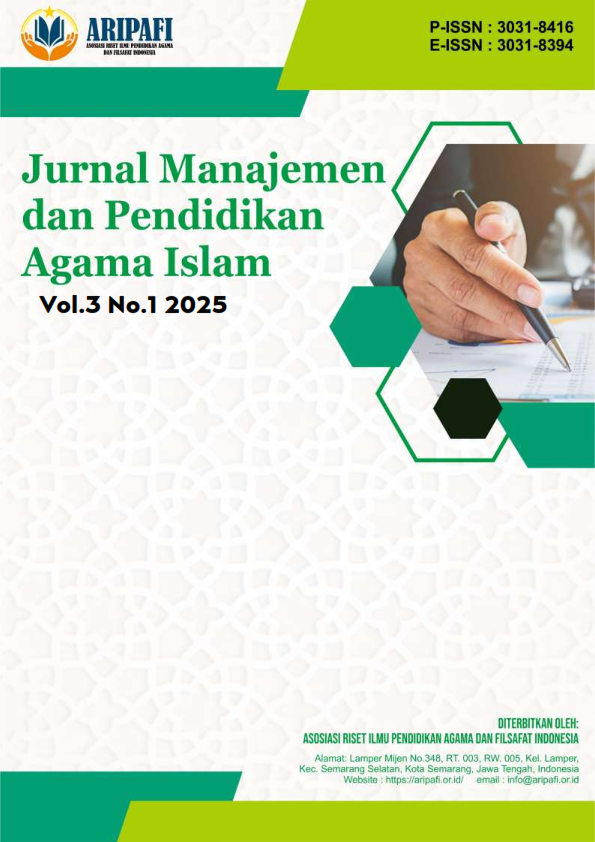Grand Desain Pendidikan Perspektif Hadis Nabi SAW
DOI:
https://doi.org/10.61132/jmpai.v3i1.831Keywords:
education, hadith, philosophical goals, and incidental goalsAbstract
Education cannot be achieved without a definite direction that has been previously determined. Hadith as the second source of law in Islamic law has established standard guidelines on philosophical and incidental goals for humans to be able to achieve the highest degree of identity before Allah SWT. With the library research method. This study attempts to examine the goals of Islamic education according to the perspective of the hadith of the Prophet SAW.,. From the results of the discussion, it can be concluded that the goals of Islamic education consist of 2 basic things, namely philosophical goals; so that humans can better recognize their true identity, in other words so that they are truly able to become caliphs on earth and incidental goals; to be able to increase motor, emotional, intellectual and spiritual intelligence which is marked by physical and spiritual maturity.
Downloads
References
Abu 'Abdillah Muhammad bin Yazid Al Qazwiny bin Majah. (n.d.). Sunan Ibnu Majah. Riyadh: Maktabah Al Ma’arif.
Abu Al Falah 'Abd Al Hayyi bin Ahmad bin Muhammad Al-'Ikry. (1988). Shadharat Al Dhahab Fi Akhbar man Dhahab (Vol. 3). Beirut: Dar Ibn Katsir.
Abu 'Isa Muhammad bin 'Isa Al Tirmidzi. (n.d.). Sunan Al Tirmidzi. Riyadh: Maktabah Al Ma’arif.
Ahmad bin 'Aly bin Hajar Al-‘Asqalani. (1994). Taqrib Al Tahdzib. Beirut: Dar Al Kutub Al ‘Ilmiyyah.
Al Qaradhawi, Y. (2001). Sunnah, Ilmu Pengetahuan dan Peradaban (Abad Badruzzaman, Terj.). Yogyakarta: Tiara Wacana.
Al-Khathib, M. 'A. (1999). Ushûl al-Hadîts, Ulûmuhu wa Musthalahuh. Beirut: Dar al-Fikr.
Al-Nawawi, Y. bin Sharaf. (1930). Al Minhaj Syarh Shahih Muslim bin Al Hajjaj (Vol. 17). Kairo: Maktabah Al Misriyyah.
Barnadib, S. I. (1993). Pengantar Ilmu Pendidikan. Yogyakarta: Andi Offset.
Humaid, S. ibn 'A. A. (2000). Thuruqu Takhrij al-Hadits. Mesir: Dar 'Ulum al-Sunnah li al-Nasyr.
Jamal Al Din Abu Al Hajjaj Yusuf Al Mizzy. (1992). Tahdzib Al Kamal Fi Asma' Al Rijal (Vol. 27). Beirut: Muassasah Al Risalah.
Laksana, I. (2012). Al Qur’an dan Terjemah New Cordova. Bandung: Syaamil Quran.
Langgulung, H. (1987). Asas-asas Pendidikan Islam. Jakarta: Pustaka Al-Husna.
Mahmud Thahan. (n.d.). Ushûl al-Takhrîj wa Dirasat al-Asanid. Mesir: Mathba’ah al-‘Arabiyyah.
Mahmud. (2011). Metode Penelitian Pendidikan. Bandung: Pustaka Setia.
Mastuhu. (2003). Menata Ulang Pemikiran Sistem Pendidikan Nasional Abad 21. Yogyakarta: Safiria Insani Press.
Muhammad bin Isma’il Al Bukhari. (1400 H). Shahih Al Jami’ (Vol. 1). Kairo: Maktabah Al Salafiyyah.
Muslim bin Hajjaj bin Muslim Al Qusyairy Al Naisabury. (1991). Shahih Muslim (Vol. 4). Kairo: Dar Al Hadith.
Safri, E. (2014). Metode Takhrij Al-Hadits. Padang: Hayfa Press.
Suharsono. (2001). Melejitkan IQ, IE & IS. Jakarta: Insani Press.
Sulaiman bin Al Ash’ath Al Sijistany Al Azdy. (1997). Sunan Abu Dawud (Vol. 4). Beirut: Dar Ibn Hazm.
Wensink, A. J. (1967). Al Mu’jam Al Mufahrath Li Alfazh Al Hadith Al Nabawiy (Vol. 2). Leiden: E. J. Brill.
Zed, M. (2008). Metode Penelitian Kepustakaan. Jakarta: Yayasan Obor Indonesia.
Downloads
Published
How to Cite
Issue
Section
License
Copyright (c) 2024 Jurnal Manajemen dan Pendidikan Agama Islam

This work is licensed under a Creative Commons Attribution-ShareAlike 4.0 International License.





